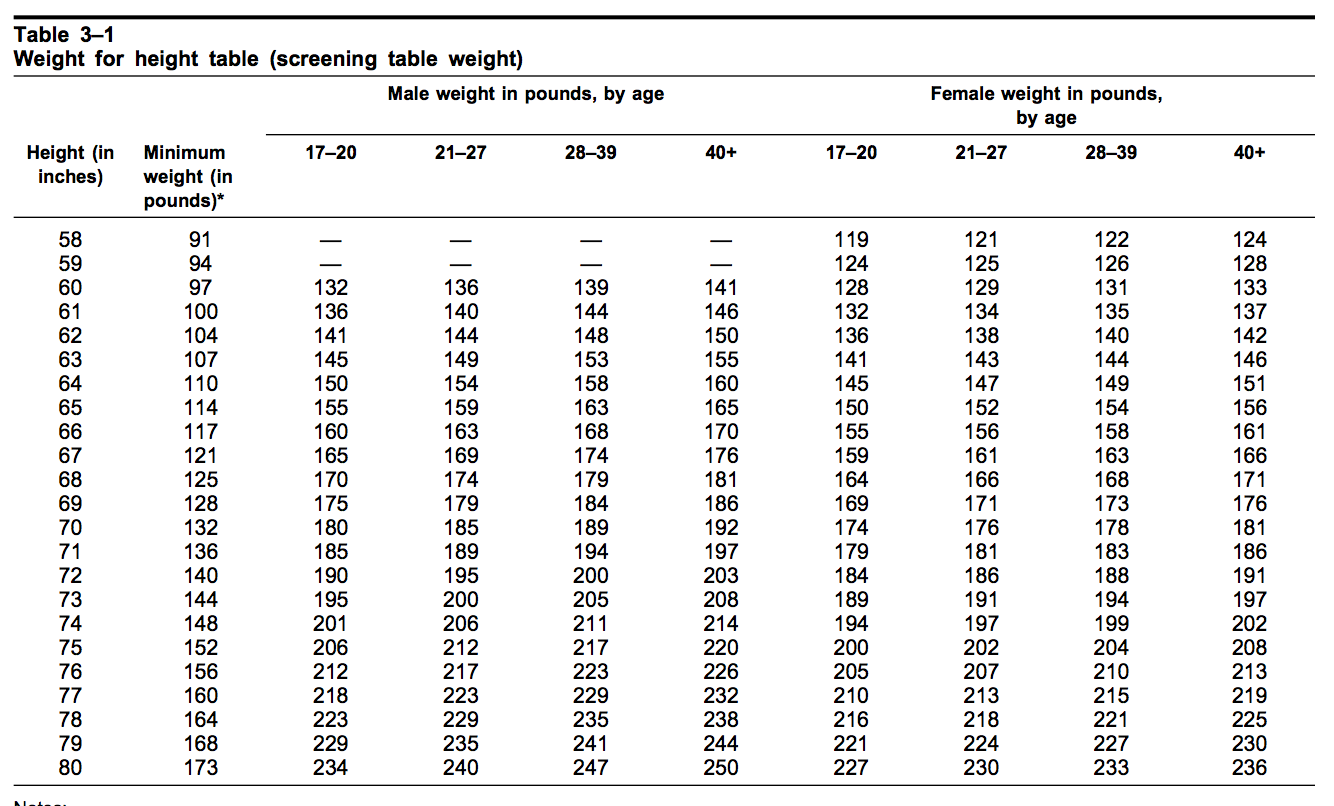The Army height and weight standards are critical for maintaining a fit and capable fighting force. As military personnel are expected to meet specific physical standards, these requirements help ensure that soldiers are prepared for the rigors of military life. With 2024 fast approaching, it's essential to understand how these standards may evolve and what implications they have for both new recruits and current personnel. This article will delve into the specifics of the Army height and weight standards for 2024, addressing common questions and providing insights into the importance of these requirements.
As we explore the Army height and weight standards for 2024, we will look at how these guidelines impact recruitment, retention, and overall military readiness. These standards are not merely arbitrary numbers; they represent the Army's commitment to ensuring that every soldier can perform at their best and meet the demands of their role. With advancements in fitness and health awareness, the Army continually assesses its standards to align with modern understandings of physical fitness.
Throughout this article, we will answer essential questions regarding the Army height and weight standards for 2024, including how these measurements are taken, what the acceptable ranges are, and how they affect service members' careers. By understanding these standards, individuals can better prepare themselves for a successful military career, ensuring they meet or exceed the expectations set forth by the Army.
What Are the Army Height and Weight Standards 2024?
The Army height and weight standards for 2024 are designed to ensure that all service members maintain a level of physical fitness that enables them to perform their duties effectively. These standards are based on a combination of height and weight tables that take into account gender and age. The Army uses these standards to evaluate recruits and current personnel, ensuring that all soldiers are fit for service.
How Are Height and Weight Measurements Taken?
The Army requires precise methods for measuring height and weight to maintain consistency and accuracy. Measurements are typically taken in a controlled environment, with soldiers required to remove shoes and wear standard military uniforms. The following steps outline the measurement process:
- Height is measured in inches using a stadiometer.
- Weight is recorded in pounds using a calibrated scale.
- Measurements are documented and compared against the Army's established height and weight charts.
What Are the Acceptable Ranges for Height and Weight?
The acceptable height and weight ranges for Army personnel vary based on age and gender. These ranges are designed to ensure that all soldiers maintain a healthy weight relative to their height. Some key points about the standards include:
- There are different height and weight standards for male and female soldiers.
- Age categories may affect the acceptable weight range.
- Soldiers who do not meet the standards may be required to participate in a body composition program.
Why Are the Army Height and Weight Standards Important?
The Army height and weight standards serve several critical purposes in maintaining a capable military force. They help ensure that soldiers are physically fit, which can directly impact their performance on the battlefield. Additionally, these standards promote overall health and wellness among service members, reducing the risk of injuries and health issues related to obesity.
How Do Height and Weight Standards Affect Army Recruitment?
As new recruits enter the Army, meeting the height and weight standards is one of the first hurdles they must overcome. Failing to meet these criteria can result in disqualification from service. The Army is continually updating its recruitment strategies and standards to attract a diverse pool of candidates while maintaining its commitment to physical fitness.
What Happens If a Soldier Does Not Meet the Standards?
Soldiers who fail to meet the Army height and weight standards may face several consequences, including:
- Enrollment in a body composition program designed to help them achieve the required standards.
- Potential impacts on promotions, assignments, and overall career progression.
- In extreme cases, discharge from the Army if standards are not met consistently.
How Is the Army Adapting to Modern Fitness Trends?
As fitness trends evolve, the Army is making efforts to adapt its height and weight standards to reflect contemporary understandings of health and wellness. This may include incorporating new fitness assessments and encouraging a broader definition of physical fitness that goes beyond simple height and weight ratios.
What Resources Are Available for Soldiers to Meet Standards?
The Army provides a variety of resources to assist soldiers in meeting height and weight standards, including:
- Access to fitness facilities and equipment.
- Nutrition education programs to promote healthy eating habits.
- Personal training and fitness classes offered on military installations.
Conclusion: Preparing for the Army Height and Weight Standards 2024
In conclusion, understanding the Army height and weight standards for 2024 is crucial for anyone considering a career in the military or for current service members aiming for advancement. By staying informed about these standards and making a commitment to physical fitness, soldiers can ensure they meet the expectations of the Army and are prepared for the challenges of military service. As the Army continues to evolve, so too will its standards, promoting a culture of health and readiness among its ranks.
You Might Also Like
Nurturing Joy: Celebrating Your Niece's Birthday With Heartfelt GIFsUnmasking The Buzz: Aishah Sophie And The Spiderman Video Phenomenon
Chandler Massey: The Rising Star Of Soap Operas
Court 8610: The Enigma Of Justice
Unveiling The Buzz: Aishah Sofey's Spiderman Video XXX
Article Recommendations
- Fikfap
- Daniel Ezra Wife
- Vegamovies Re Hindi Dubbed
- Baby Suji
- Tina Trahan Age
- Sophie Rain Only Fans Leaks
- Laralane Onlyfans
- Loni Willison Now
- Kimberly Guilfoyle
- Things To Draw When Bored Easy


